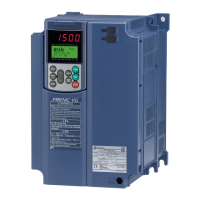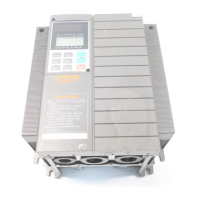5.3 Description of Function Codes
5-51
FUNCTION CODES
Chap 5
For single polarity (Terminal [12] (C35=1), Terminal [C1] (C1 function), Terminal [C1] (V2 function)
As the above diagram indicates, for reference frequency and analog input of frequency setting 1, it is possible to
set arbitrary relationship by A point (determined by bias (F18) and bias reference point (C50)) and B point
(determined by the gain corresponding to each analog input and the gain reference point (C32 and C34, C37 and
C39, and C42 and C44)).
For reference frequency and analog input of frequency setting 2 (C30), it is possible to set arbitrary relationship by
A point (determined by bias and bias reference point (C55 and C56, C61 and C62, and C67 and C68)) and B point
(determined by the gain corresponding to each analog input and the gain reference point (C32 and C34, C37 and
C39, and C42 and C44)).
Both data of bias and gain are set with 100% as the maximum frequency. The data of bias reference point and gain
reference point are set up with full scale of analog input (10V or 20mA) as100%.
By setting the bias to minus value, even if the analog input is unipolar, it is possible to perform frequency setting as
bipolar. For terminal [C1] (C1 function), C40 is set to 10 or 11, and for terminal [C1] (V2 function), C45 is set to 1,
and then, the frequency setting at analog input at or below 0 point becomes negative polarity, as a result, it
becomes possible to perform forward and reverse operation only by analog command.
<Frequency setting 1: F01>
•
Analog input at or below bias reference point (C50) is restricted by bias value (F18).
When the value set in bias reference point (C50)≥ each gain referenc
e point (C34, C39, C44), it is
judged as incorrect setting and reference point becomes 0 Hz.
<Frequency setting 2: C30>
Analog input at or below bias reference point (C56, C62, and C68) is restricted by bias value (C55,
When the value set in bias reference point (C56, C62, C68) ≧
each gain reference point (C34, C39,
C44), it is judged as incorrect setting and reference point becomes 0 Hz.
Example) When setting reference frequency to 0 to 60 Hz by analog input (terminal [12]) 1 to 5V
(When maximum frequency is F03=60 Hz)
(A point)
In order to set reference frequency to 0 Hz when analog input is 1V, set bias (F18) to 0%. At this point, 1V has to
become the bias reference point and 1V is equivalent to 10% against full scale 10V of terminal [12], therefore, set
the bias reference point (C50) to 10%.
(B point)
In order to set reference frequency so that the frequency becomes the highest when analog input is 5V, set the
gain (C32) to 100%. At this point, 5V has to become the gain reference point and 5V is equivalent to 50% against
full scale 10V of terminal [12], therefore, set the gain reference point (C34) to 50%.
The setting method without changing reference point and by using gain and bias individually is the same
as for
Fuji electric inverter of old model.
(Maximum frequency: converted with F03 = 60 Hz as 100%)
(Analog input full scale:
converted with 10 V as 100%)

